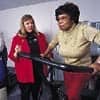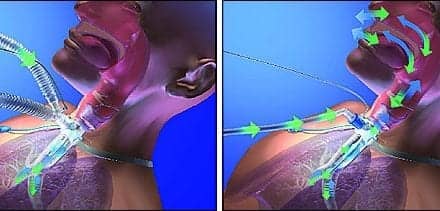
Richard Casaburi, PhD, MD, and his team at LA BioMed supervise the pulmonary rehabilitation of a patient with COPD. Casaburi is principal investigator, LA BioMed, and associate chief for research, Division of Respiratory and Critical Care Physiology and Medicine, Harbor-UCLA Medical Center, Torrance, Calif.
Pulmonary rehabilitation (PR) is poised to make a big impact on the lives of COPD patients if all the right ingredients come together to push it forward. A review of published literature has proven that pulmonary rehabilitation programs have a significant impact on the health of COPD patients as reflected in many measurable parameters (such as improved quality of life; decreased dyspnea; more endurance; increased inspiratory, leg, and upper arm muscle strength; and reduction in hospital readmissions). Research has also shown that these health benefits can be sustained over time.1,2 In 2008, the US Congress passed the Medicare Improvements for Patients and Providers Act that made pulmonary rehabilitation a covered Medicare benefit (the law took effect in January 2010).3 So, pulmonary rehabilitation can make life better, reduce costs, and has reimbursement dollars available to support it. But it continues to be underutilized in the United States and is not even available in some countries around the world. (It was estimated that in 2005 only 1% to 2% of the COPD patients in Canada had access to pulmonary rehabilitation.4) This article will look at some of the research done in pulmonary rehabilitation related to the protocols, processes, measurements, and outcomes, and we’ll examine the future and see what changes are needed to increase the utilization of pulmonary rehabilitation.
Protocol and Process: Home-Based Pulminary Rehabilitation
One major area that is changing for pulmonary rehabilitation is in the structure/process used for providing the program for patients (see Sidebar). There is a large body of evidence that supports home-based programs for a majority of COPD patients versus using a centralized hospital-based or community-based approach (referred to as outpatient rehabilitation). The distinctions of the home-base programs are that the patient actually does the main portion of the program at home, and there is not direct supervision provided in the home after the program ends. In many of the comparison studies, both groups usually had a 4- to 6-week educational program provided at a centralized location, then about 8 weeks in the rehabilitation program, which was done either at home or in an outpatient center. Many studies performed a follow-up evaluation at the end of 6 months or 12 months after completion of the programs to evaluate the patient’s health status. A Canadian study from 2008 showed that using a home-based program is equivalent to outpatient rehabilitation for patients with moderate to severe COPD. The evidence gathered included scores on the Chronic Respiratory Questionnaire (CRQ) and the St. George’s Respiratory Questionnaire (SGRQ), as well as results from 6-minute walk time and cycling endurance time. The study involved 252 patients from 10 academic and community medical centers and followed the patients over the course of 1 year. These patients had 4 weeks in the education phase followed by 8 weeks in either home-based or outpatient center-based rehabilitation, then 40 weeks in the maintenance phase (to conclude the research after 1 year). The maintenance phase included phone calls every 2 months to both groups that reinforced the intended behaviors learned in the program, provided support, and answered patient questions.4
Defining Pulmonary Rehabilitation
In 2006, the American Thoracic Society and the European Respiratory Society published updated, evidence-based guidelines on pulmonary rehabilitation. In the published statement, they defined pulmonary rehabilitation in this way:
“Pulmonary rehabilitation is an evidence-based, multidisciplinary, and comprehensive intervention for patients with chronic respiratory diseases who are symptomatic and often have decreased daily life activities. Integrated into the individualized treatment of the patient, pulmonary rehabilitation is designed to reduce symptoms, optimize functional status, increase participation, and reduce health care costs through stabilizing or reversing systemic manifestations of the disease.”10
A systematic review published in 2010 of randomized clinical trials compared home-based pulmonary rehabilitation to hospital-based pulmonary rehabilitation. Twelve of the studies met the inclusion criteria and were evaluated (out of a pool of 888 articles). The researchers found there was no significant difference statistically or clinically in a comparison of health-related quality of life for home versus hospital pulmonary rehabilitation nor was there a significant difference statistically or clinically in a comparison of exercise capacity. Their conclusion was that home-based pulmonary rehabilitation is equivalent to outpatient rehabilitation.5,6 Changing from outpatient programs to home-based programs can expand access for many patients; there are many patients with COPD who do not live close to an outpatient clinic or health care facility and must travel many miles in the rural setting or through urban areas with significant traffic issues to gain access to a PR location.7 There may be issues with cost to the patient in shifting to the home environment, though, if special exercise equipment is needed at home (eg, a treadmill, stationary bicycle, weights). In addition, the program needs to include several components to ensure a comprehensive approach. These components include patient education, physiotherapy, exercise testing and training, nutritional counseling, and psychosocial support.1
Measurements and Outcomes: 6-Minute Walk Test
The outcomes of pulmonary rehabilitation have often been measured by responses to health-related quality of life surveys (such as the CRQ and SGRQ) and improvement in 6-minute walk tests (6MWTs). Some research has included the incremental shuttle walk test and the endurance shuttle walk test. These three walk tests have been associated with measurement of exercise capacity and leg strength. The 6MWT has been a standard for many research projects, but one study has questioned its use to document desaturation when prescribing ambulatory oxygen. This study examined 88 COPD patients on 3 separate days using the 6MWT to check for desaturation (an Spo2 <88% during exercise will qualify the patient to have ambulatory oxygen prescribed). Investigators found that 51 of the patients desaturated to <88% on at least one test but only 26 patients had this occur with all three tests. If the criteria to qualify for supplemental oxygen called for consistent, reproducible desaturation measurements during exercise, then some two thirds of the patients would not qualify. On the other hand, if those who desaturated to <88% on at least one but not all tests were subjected to a qualifying evaluation that missed the desaturation, 40% who might have benefited from oxygen would not qualify.8 This variability may link to use of the 6MWT in evaluating pulmonary rehabilitation outcomes—further study is needed in this area.
The Future of Pulmonary Rehabilitation
To be most effective, pulmonary rehabilitation must come at the right time, involve the right therapy, and carry forward in time to bring meaningful change. A group of 20 experts from North America and Europe gathered to discuss the future of pulmonary rehabilitation. The following statements came from the article published out of this meeting9:
“Pulmonary rehabilitation involves a coordinated multidisciplinary treatment plan that focuses on all aspects of the disease over time and is indeed a component of integrated care.”
“Therapies may include smoking cessation intervention, promotion of a healthy lifestyle (including increased activity and regular exercise), collaborative self-management strategies, optimal pharmacotherapy, palliative therapy, and end-of-life care. This necessitates partnering, communication, and coordination among primary and specialty healthcare professionals, patients, and their families.” This group made recommendations in three major areas, with particular items included to focus efforts and establish goals:
1. Pulmonary rehabilitation and integrated care of the COPD patient
- Multidisciplinary, collaborative, and individualized
2. Increasing the effectiveness of pulmonary rehabilitation
- Promoting exercise and activity
- Education and self-management
- PR program structure and duration
- Psychosocial intervention
- Pharmacologic therapy and PR
- Oxygen therapy and PR
- Other modalities (interval training, heliox, NPPV)
- * Palliative care
3. Increasing referral and entry into PR
- Expanding the indications for PR in COPD (the postextubation period, other applications and settings)
- Training of health care professionals
- Increasing availability of programs9
Research is ongoing to find the best ways for providing optimal pulmonary rehabilitation. Starting up home-based programs and assessing the conventional approaches (like the 6-minute walk test) are two examples of change and improvement in this field. Still, pulmonary rehabilitation has proven its worth and is in need of some champions to bring it in to full use. The strong multidisciplinary approach cries out for these champions to come from several professions, including physicians, nurses, respiratory therapists, physical and occupational therapists, nutritionists, exercise physiologists, and psychologists. COPD patients gain so much benefit from pulmonary rehabilitation—we need to push this to the forefront and offer this program to these patients in every nation. Those health care professionals involved in PR have seen the impact. For those not involved, this area has potential to be very big in the near future, and health care professionals should be watching for opportunities to join in this effort, or, better yet, begin to make the opportunities happen.
Bill Pruitt, MBA, RRT, CPFT, AE-C, is a senior instructor and director of clinical education in the department of cardiorespiratory sciences, College of Allied Health Sciences, University of South Alabama in Mobile, and a PRN therapist at Springhill Medical Center and Mobile Infirmary Medical Center in Mobile, Ala. For further information, contact [email protected].
References
- Moullec G, Laurin C, Lavoie KL, Ninot G. Effects of pulmonary rehabilitation on quality of life in chronic obstructive pulmonary disease patients. Curr Opin Pulm Med. 2011;17:62-71.
- Spencer LM, Alison JA, McKeough ZJ. Maintaining benefits following pulmonary rehabilitation: a randomised controlled trial. Eur Respir J. 2010;35:571-7.
- Birnbaum S. Pulmonary rehabilitation: classic tune with a new beat, but is anyone listening? CHEST. 2011;139:1498-1502.
- Maltais F, Bourbeau J, Shapiro S, et al. Effects of home-based pulmonary rehabilitation in patients with chronic obstructive pulmonary disease: a randomized trial. Ann Intern Med. 2008;149:869-78.
- Vieira DS, Maltais F, Bourbeau J. Home-based pulmonary rehabilitation in chronic obstructive pulmonary disease patients. Curr Opin Pulm Med. 2010;161:34-43.
- Bourbeau J. Making pulmonary rehabilitation a success in COPD. Swiss Med Wkly. 2010;140:w13067.
- Fernandez AM, Pascual J, Ferrando C, Sevilla V. Home-based pulmonary rehabilitation in very severe COPD: is it safe and useful? J Cardiopulm Rehabil Prev. 2009;29:325-31.
- Chatterjee AB, Rissmiller RW, Meade K, et al. Reproducibility of the 6-minute walk test for ambulatory oxygen prescription. Respiration. 2010;79:121-7.
- Nici L, Raskin J, Rochester CL, et al. Pulmonary rehabilitation: WHAT WE KNOW AND WHAT WE NEED TO KNOW. J Cardiopulm Rehabil Prev. 2010;29:141-51.
- Nici L, Donner C, Wouters E, et al. American Thoracic Society/European Respiratory Society Statement on Pulmonary Rehabilitation. American Thoracic Society Documents. 2006. Available at: www.thoracic.org/statements/resources/respiratory-disease-adults/atserspr0606.pdf. Accessed August 12, 2011.









